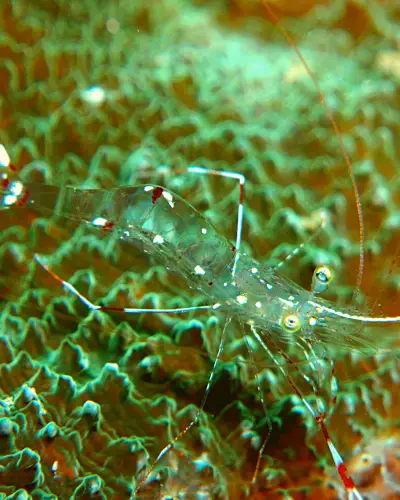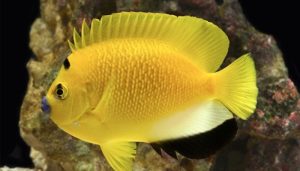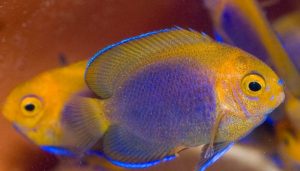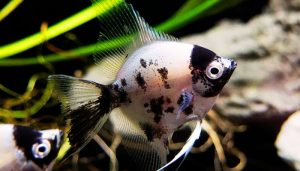If you’ve ever admired the delicate beauty of ghost shrimp and the vibrant charm of betta fish, you might wonder: Can ghost shrimp live with bettas? This pairing can create a visually stunning aquarium, but it’s not always as straightforward as it seems.
Ghost shrimp and bettas can coexist, but their harmony depends on how you introduce them and manage their environment. Understanding their behavior and needs is crucial to fostering a peaceful underwater community.
To ensure ghost shrimp adjust well to their new home, it’s essential to introduce them carefully. One key step is to remove the betta fish before adding the shrimp.
This gives the shrimp time to settle into the tank without stress or the betta’s initial curiosity, which might come across as territorial aggression. Once the shrimp are adjusted, you can reintroduce the betta, and they should coexist peacefully with minimal conflict.

Ready to dive deeper? Keep reading to uncover tips, tricks, and expert advice for creating a thriving, mixed-species aquarium. Discover how to make this aquatic duo a success!
Table of Contents
ToggleCan Ghost Shrimp and Betta Fish Live Together?
Many aquarium hobbyists wonder if ghost shrimp and betta fish can coexist peacefully in a tank. The answer is not straightforward, as it largely depends on the individual personalities of the fish and the tank setup. Bettas are known for their aggressive behavior, particularly towards smaller tankmates like ghost shrimp.
However, with appropriate precautions, both species can live together harmoniously. It’s crucial to provide ample hiding places for ghost shrimp, such as rocks and live plants, to help them escape the betta’s attention.
If the betta feels threatened or territorial, it may attack the shrimp, leading to a grim outcome for the shrimp. Therefore, careful monitoring is essential when introducing these two species into the same aquarium.
When considering a shared habitat, an important aspect is the size of the tank. A larger tank, preferably over 10 gallons, can help mitigate aggression by providing more space for both the betta and the shrimp to swim and hide.
Additionally, introducing ghost shrimp when the betta is still acclimating to the tank can sometimes reduce the likelihood of aggressive interactions. Despite the risks, many aquarists have successfully kept ghost shrimp and bettas together, proving that with the right conditions, harmony can be achieved.
Identical Parameters for Domestication
To ensure that glass shrimp and betta fish thrive in the same aquarium, it is vital to maintain identical parameters for their domestication. Both species prefer a freshwater environment with stable water parameters, including temperature, pH, and hardness.
Bettas typically thrive in temperatures ranging from 76 to 82 degrees Fahrenheit, while ghost shrimp enjoy similar conditions. The pH level should be kept between 6.5 and 7.5, which accommodates both species. Regular testing of these parameters is crucial to prevent any drastic changes that could stress the fish and shrimp.
Moreover, the tank’s water should be clean and well-filtered, as both ghost shrimp and bettas are sensitive to toxins and pollutants. Regular water changes of about 25% each week can help maintain a healthy environment.
It’s also essential to consider the tank mates and the overall ecosystem. Introducing live plants can improve water quality and provide hiding spots for ghost shrimp, giving them a better chance of avoiding aggressive interactions with the betta. By carefully managing these parameters, both species can flourish together in a well-maintained aquarium.
Biological Different Species
Ghost shrimp and bettas are biologically different species with distinct behaviors and needs. Bettas, or Betta splendens, are known for their vibrant colors and long fins, and they are often aggressive, especially towards other fish.
In contrast, ghost shrimp, a type of freshwater shrimp, are more peaceful and tend to scavenge for food along the tank bottom. Their feeding habits include consuming algae and leftover fish food, making them beneficial for maintaining tank cleanliness.
However, their small size makes them vulnerable to bettas, which may see them as a potential snack.
It’s important to recognize these biological differences when considering their coexistence. A betta’s natural instincts may lead it to attack ghost shrimp if the shrimp are not adequately hidden or if the betta feels threatened.
On the other hand, ghost shrimp require a safe environment to thrive and reproduce. If kept together, providing ample hiding spots, such as plants or decorations, can help mitigate the risk of aggression. Understanding these biological differences is key to successfully keeping ghost shrimp and bettas in the same aquarium.
Setting up a Ghost Shrimp and Betta Tank
Setting up a tank for ghost shrimp and betta fish requires careful planning and consideration. Start by choosing an appropriately sized aquarium; a minimum of 10 gallon betta fish tank is recommended to provide enough space for both species.
When creating the tank setup, include plenty of hiding places using rocks, driftwood, and live plants. These features not only enhance the aesthetics of the aquarium but also provide ghost shrimp with safe spots to retreat when the betta becomes aggressive.
Additionally, consider the substrate; a soft, sandy bottom is ideal for shrimp, as it allows them to dig and forage comfortably.
When introducing these two species into the tank, it’s best to add the ghost shrimp after the betta has established its territory. This approach can help reduce territorial disputes.
Furthermore, ensure that the tank is well-cycled before adding any inhabitants, as a stable environment will promote the health of both the betta and the shrimp. Monitoring water quality, temperature, and overall tank conditions regularly will help maintain a harmonious living space. With the right setup, ghost shrimp and bettas can coexist peacefully, creating a dynamic and vibrant aquarium.
Feed Type, Technique and Frequency
Feeding ghost shrimp and betta fish involves understanding their dietary requirements and preferences. Bettas are carnivorous and thrive on high-protein foods, such as pellets, flakes, or frozen options like bloodworms and brine shrimp.
On the other hand, ghost shrimp are omnivorous scavengers that primarily feed on algae, leftover fish food, and specially formulated shrimp pellets. To ensure both species receive adequate nutrition, it’s advisable to provide a varied diet tailored to their specific needs. Feeding them at different times can also help prevent competition for food.
When feeding, sprinkle a small amount of betta food on the water’s surface and scatter shrimp food near the bottom of the tank. This technique allows both the betta and the shrimp to access their meals without interference. It’s crucial to avoid overfeeding, as uneaten food can lead to water quality issues.
A balanced feeding schedule, with small portions offered once or twice a day, will keep both species healthy. By paying attention to their dietary needs, you can foster a thriving community within your aquarium.
Signs of an Attack
Being aware of the signs of an attack between a betta and ghost shrimp is crucial for maintaining a peaceful aquarium environment. Bettas can display aggressive behavior through physical signs, such as flaring their fins and changing color when threatened or excited. If a betta shows increased aggression towards ghost shrimp, it may swim rapidly towards them or chase them around the tank. Additionally, a betta may attempt to nip at the shrimp, which can result in injury or even death for the smaller creature.
To prevent such incidents, keep a close eye on their interactions, especially during the initial introduction phase. If you notice the betta consistently targeting the shrimp, consider providing more hiding spots or relocating the shrimp to a different tank. Monitoring the behavior of both species will help you respond quickly to any signs of aggression, ensuring the safety of the ghost shrimp. Understanding these warning signals is essential for fostering a harmonious aquarium environment where both ghost shrimp and bettas can coexist.
Conclusion
So, can betta fish live with ghost shrimp? In conclusion, while it is possible for ghost shrimp and betta fish to live together in the same aquarium, it requires careful consideration and management. Understanding their biological differences, maintaining identical water parameters, and creating a suitable tank environment are essential steps for promoting harmony. By ensuring adequate hiding places and monitoring their interactions, aquarists can successfully keep these two species together. It’s important to stay observant for any signs of aggression and provide the necessary care to both species. With diligence, ghost shrimp and betta fish can thrive in a shared aquatic ecosystem.
Ultimately, the success of keeping betta fish and ghost shrimp together depends on the individual personalities of the fish and the specific conditions of the tank. While some bettas may tolerate the presence of shrimp, others may exhibit aggressive behavior that could jeopardize the shrimp’s safety. Therefore, it is essential for aquarists to remain proactive in maintaining a balanced environment. By following best practices and being attentive to the needs of both species, you can create a vibrant aquarium where both ghost shrimp and bettas flourish.
Can Ghost Shrimp Live with Betta Fish in Same Tank (FAQs)
Can ghost shrimp co-exist with betta fish in a tank?
Yes, ghost shrimp can co-exist with betta fish, but caution is needed. Bettas may get aggressive towards shrimp, especially if they see them as prey.
What is the ideal tank size for keeping ghost shrimp and bettas together?
A minimum of a 10-gallon betta fish tank is recommended to provide enough space for both species and to reduce stress and aggression.
How do I ensure peaceful cohabitation between ghost shrimp and bettas?
To promote peaceful cohabitation, provide plenty of hiding spots using plants, leaf litter, and decorations. This allows shrimp to escape if the betta becomes aggressive.
Will bettas eat ghost shrimp?
Do bettas eat ghost shrimp? Bettas may eat ghost shrimp, especially younger or smaller shrimp. It’s essential to monitor their interactions to prevent any issues.
How often do I need to perform maintenance on a tank with ghost shrimp and bettas?
A: Weekly maintenance is recommended to keep water quality high, which benefits both ghost shrimp and bettas. Regular water changes and filter maintenance are crucial.
Can I keep amano shrimp and ghost shrimp in the same tank with a betta?
Can amano shrimp live with betta? Yes, amano shrimp are generally more robust and may be able to coexist better with bettas compared to true ghost shrimp, but still require monitoring for aggression.
What should I feed ghost shrimp if I have them in a betta fish tank?
Ghost shrimp can eat algae wafers, blanched vegetables, and small amounts of fish food. Ensuring they have a varied diet helps maintain their health.
What happens if my betta gets aggressive towards the ghost shrimp?
If your betta becomes aggressive, it may injure or kill the ghost shrimp. If this occurs, it’s best to separate them or provide more hiding spots for the shrimp.
Are there any diseases that can affect ghost shrimp in a fish tank?
Yes, ghost shrimp can be susceptible to diseases like shrimp molting problems or bacterial infections. Maintaining good water quality helps prevent these issues.
Where can I purchase ghost shrimp and bettas for my tank?
You can find ghost shrimp and bettas at local pet stores like PetSmart or online retailers. Ensure you choose healthy specimens from reputable sources.
Can a betta and cherry shrimp live together?
Yes, betta fish and cherry shrimp can often live together peacefully. However, some bettas may prey on shrimp, so careful observation is crucial
Should a shrimp or snail be better for a 5 gallon tank?
Snails are generally better suited for a 5-gallon tank than shrimp. Shrimp tend to produce more waste and require better filtration than snails.
Recommended Posts
- How Big Does Ghost Shrimp pet Get: Let’s Clear Up the Confusion!
- How Often Do Ghost Shrimp Lay Eggs: (A Comprehensive Guide)
- How Many Ghost Shrimp Per Gallon Of Water: (A Comprehensive Guide)
- How Long Do Ghost Shrimp Live In A Tank: (Prolong Their Lifespan)
- What Food Does a Ghost Shrimp Eat: Top 5 Foods For Optimal Health
- Do Ghost Shrimp Molt: What Does It Looks Like & What to Do?
- Are Ghost Shrimp Aggressive towards fish: (5 Reasons & Proven Solutions)
- Are Ghost Shrimp Neocaridina the Ultimate 10X Color Boosters




